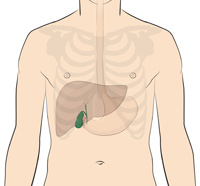Robotic Cholecystectomy for Gallbladder Disease
The gallbladder, though a relatively small organ, is vital to healthy gastrointestinal function. This pear-shaped organ stores bile, a liquid created by your liver to aid in fat digestion. When functioning correctly, the gallbladder releases bile to the small intestine through a tube called the common bile duct.

There are many forms of gallbladder disease, but common symptoms cause inflammation, infection or blockage of the gallbladder, as well as gallstones. Types of gallbladder disease include:
Cholecystitis—The medical term for inflammation of the gallbladder, cholecystitis is caused by blockages of the common bile duct. Usually, these blockages are the result of gallstones, but can also be caused by infection, injury or tumors. If not treated, serious complications like tissue damage, tears in the gallbladder and infection can occur. Most people with this condition will eventually require surgery to remove the gallbladder.
Gallstones—These small, hard stones form in the gallbladder from hardened substances in the bile. They range in size from smaller than a grain of sand to as large as a golf ball. Gallstones are very common and often do not require treatment. However, when a gallstone begins to block a duct, they usually demand medical attention. Occasionally, symptoms recur regularly and total removal of the gallbladder is necessary.
Gangrene or abscesses of the gallbladder—When acute cholecystitis goes untreated, tissues of the gallbladder can begin to decay, a condition known as gangrenous gallbladder. Symptoms include high fever, shaking chills, nausea, and digestive system problems. Those at highest risk are men over 50 with a history of high levels of infection or heart disease.
Gallbladder Polyps or Tumors—A common condition, gallbladder polyps are typically harmless growths that protrude from the inside of the gallbladder wall. If polyps begin to grow larger than one centimeter, they are more likely to become cancerous and often require the full removal of the gallbladder.
Sclerosing cholangitis—This condition causes the swelling, scarring and destruction of the bile ducts inside and outside of the liver. Causes for sclerosing cholangitis are often unknown, though genetic factors may be involved. Although there may be no symptoms, the first signs are usually fatigue and jaundice, followed by a loss of appetite, weight loss, enlarged liver and/or spleen and chronic cholangitis (bile duct infection).
Symptoms of and Treatment for Gallbladder Disease
Because most gallbladder diseases are related to blockages, symptoms can be similar. These symptoms are often referred to as “attacks” because of their sudden, sharp pain. These attacks regularly follow fatty meals or occur during the night and may cause:
- A steady pain in the right upper abdomen that can last anywhere from thirty minutes to several hours
- Pain between the shoulder blades
- Pain under the right shoulder
Contact your doctor if you have experienced the following symptoms:
- Upper abdominal or upper back pain lasting for more than five hours
- Nausea and vomiting
- Fever or chills
- Yellowing of the skin or whites of the eyes
- Clay-colored stools
Although dietary changes may offer a solution to some gallbladder conditions, physicians often prescribe antibiotics to treat infections. When diet and antibiotics fail to treat symptoms, surgical removal of the gallbladder, or cholecystectomy, is often recommended. Traditional cholecystectomy requires a long, open incision to access the small, remote gallbladder. This form of surgery can require a longer hospital stay and recovery time.
If your doctor recommends cholecystectomy to treat your gallbladder condition, ask about the minimally-invasive robotic gallbladder removal surgery at The Jackson Clinic. This revolutionary procedure allows for full cholecystectomy to be conducted through the tiniest of incisions, with reduced recovery time, shorter hospital stay and fewer complications. The Jackson Clinic robotic general surgeon uses the da Vinci surgical platform to treat gallbladder disease in patients from all across West Tennessee and the Mid-South, including Memphis, Tupelo, Jonesboro and Paducah.
